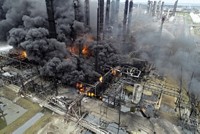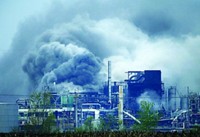Advertisement
Grab your lab coat. Let's get started
Welcome!
Welcome!
Create an account below to get 6 C&EN articles per month, receive newsletters and more - all free.
It seems this is your first time logging in online. Please enter the following information to continue.
As an ACS member you automatically get access to this site. All we need is few more details to create your reading experience.
Not you? Sign in with a different account.
Not you? Sign in with a different account.
ERROR 1
ERROR 1
ERROR 2
ERROR 2
ERROR 2
ERROR 2
ERROR 2
Password and Confirm password must match.
If you have an ACS member number, please enter it here so we can link this account to your membership. (optional)
ERROR 2
ACS values your privacy. By submitting your information, you are gaining access to C&EN and subscribing to our weekly newsletter. We use the information you provide to make your reading experience better, and we will never sell your data to third party members.
Safety
OSHA Targets Combustible Dust
Getting facilities to recognize the problem will lead to better controls
by David J. Hanson
June 6, 2011
| A version of this story appeared in
Volume 89, Issue 23

Dust explosions and fires plague many workplaces and industries. Under the right conditions, dust from metals, foods, paper, polymers, and wood can explode and cause injury and death.
For the first time, the Occupational Safety & Health Administration is developing a comprehensive rule to protect workers at facilities that generate combustible dust. After more than a year of stakeholder briefings and expert panel conferences, the agency hopes to propose its regulations later this year. OSHA published its Advanced Notice of Proposed Rulemaking on Oct. 21, 2009.
But the agency faces a daunting task. Thousands of facilities, mostly small, generate potentially dangerous dust in their manufacturing processes and will fall under a combustible dust regulation. There is also an unknown universe of types of dust that must be addressed by any new rule. And OSHA must find answers to a lot of questions about the scope and details of the upcoming rule, such as testing requirements, company awareness, and exemptions for small businesses.
An average of seven fatalities and 35 injuries per year resulted from combustible dust incidents between 1999 and 2010, OSHA reports. These figures might even be higher, OSHA admits, because it doesn’t have good data on all of the possible incidents.
The push for better protection of workers from dust explosions came from the federal Chemical Safety & Hazard Investigation Board (CSB). Its investigations of accidental industrial deaths often found combustible dust to be the cause of the incident. By 2006, CSB had compiled a report for OSHA describing a 25-year history of serious dust-related accidents. The report urged OSHA to issue a new standard to prevent combustible dust fires at industrial facilities. The standard, the board suggested, should include requirements for hazard assessments, engineering controls, building design, housekeeping, and worker training.
“We believe that there needs to be a comprehensive approach to this explosive hazard,” says Rafael Moure-Eraso, the chairman of CSB. “Combustible dust is an old hazard that we know is preventable. It is a hazard that has a solution, and it is possible to address the problem. The faster we get a nationwide regulation, the sooner we are going to prevent the loss of life in industry.”
At a forum convened by OSHA last month to review technical issues of the proposed regulation, a panel of experts discussed how to determine whether a particular dust is hazardous. Testing protocols to assess how explosive a dust might be do exist, but as the panel made clear, a number of conditions affect the actual hazard, including dust volume, humidity, particle size, and chemical makeup of the dust. Testing can also be expensive.
Some of the experts told OSHA that if any dust is present at a plant, it should be tested to determine its potential danger. Others stated that if a company knows that fine dust is generated in its plant, it should already realize there is a potential problem.
“The basic hazard recognition can come from just an awareness of the chemical nature of your material,” Walter L. Frank, president of Frank Risk Solutions, a dust hazard consulting company, tells C&EN. “If it’s a hydrocarbon and it’s finely divided, you have a concern. If it’s a metal, you’ve probably got a concern. What you need testing for is in quantifying the explosion hazard and in designing the safety systems.
“As little as a 32nd of an inch of combustible dust, if suspended, can produce an explosive cloud in a column 10 feet high,” Frank explains. “It’s a challenge to get people to recognize that.”
OSHA’s thorniest problem, then, may be getting facilities to see that they have a dust hazard. “There probably are industries out there operating with combustible materials, and the owners might not be aware of the potential danger because they have not found the need to do testing,” Guy R. Colonna, division manager for industrial and chemical engineering for the National Fire Protection Association (NFPA), tells C&EN.
“In many cases, a concern about dust just doesn’t enter into companies’ thought processes,” Frank says. “Catastrophic dust explosions are very rare, and most facilities are not going to see one. Until you have a basis for appreciating the hazard, either by learning from another’s misfortune or being unlucky enough to have an incident yourself, some people just don’t recognize that the hazard exists,” he points out.

Steven J. Luzik, senior process safety specialist at Chilworth Global, a process safety consulting firm, echoes Frank. “There are a lot of people out there who feel their dust is not a problem and that OSHA should just leave them alone,” he says. “A big hurdle for OSHA is going to be getting those people together with what the agency is trying to do.”
Another tricky area for the OSHA officials drafting a dust rule is existing voluntary standards. These standards recommend testing as well as engineering and administrative controls to manage dusts. NFPA, for example, has been writing voluntary consensus standards on combustible dusts since the 1920s, and it presently has five standards on dusts advising companies on how to prevent fire and explosion hazards. The standards are also updated regularly. However, Colonna says, NFPA has no data on the number of companies that generate potential dust hazards, because its standards are voluntary and the association does not provide any enforcement.
“In our initial response to the [Advanced Notice of Proposed Rulemaking], we recommended to OSHA that it strongly consider the NFPA standards” as part of its regulations, Colonna says. OSHA can then “adapt its regulations as needed for the areas that our standards do not cover.”
And because many plants currently use the NFPA standards for controlling dust hazards, Colonna notes, OSHA should make sure any new controls are compatible. “If the OSHA controls are so new and dramatically different from those at existing facilities, it will be a big concern on how to implement those practically and economically and not injure smaller businesses,” he says.
“Enforcement will be quite a challenge,” Frank says, because so many facilities have processes that can generate combustible dust and would therefore fall under a dust standard. “The issue is ubiquitous. It’s hard to envision OSHA having enough inspectors to get into all the facilities they need to get into.”
Still, the OSHA standard is expected to result in better management of combustible dust. “When an OSHA standard becomes law, companies will be forced to comply,” Luzik says. “OSHA will be able to write citations, and if the company does not comply, OSHA has the regulatory power to shut down the operation. The burden is on the industry to step up and meet the standard.”
OSHA officials must also decide how many and what plants the dust regulation should cover, Colonna points out. “I think a concern exists over whether there is a need to exclude some industries based on their size or the number of employees,” he says. The agency has received many comments that smaller plants may not be able to afford the engineering testing or hazard analysis that larger firms employ. But most experts agree that such testing will have to be done.
“The issue of how to handle the small mom-and-pop operations has arisen before,” according to Luzik, who has been inspecting facilities for dust hazards for 30 years. “My opinion is that the hazards are real, regardless of the size of the operation, and bad things can happen. I have seen many small operations where dust fires have occurred. There has to be some minimal level of safety incorporated.”
CSB’s Moure-Eraso agrees. “Plant size should not be what determines who is protected,” he says. “I don’t think it is especially onerous for a company to do a hazard assessment and find out what dangers are in its particular circumstances. Any investment made to assess your hazards will pay off tremendously compared to the expenses you would face if something went wrong.”
One of the final steps OSHA must take in preparing its proposed standard is to convene a panel mandated by the Small Business Regulatory Enforcement Fairness Act. This panel will try to assess how new regulation might economically affect small enterprises.
Observers agree that a key part of the standard should simply be good housekeeping; that is, if facilities are cleaned regularly, dust will not build up and be a hazard. “The priority should be controlling the dust in the first place; don’t let it be created,” Colonna says. Other experts have seen firsthand that the housekeeping at many facilities is poor and that many plant operators don’t seem to understand the fundamental issues of combustible dust.
Good housekeeping will also save companies money, experts say. “Taking care of housekeeping can lead to cutbacks in other control measures” and reduce costs, Colonna says. Insurance companies estimate that $1.00 invested in dust prevention can save about $10 in spending on expensive engineering controls.
Even though OSHA is expected to propose a combustible dust rule late this year, it will be at least another year before a final rule is in place. But companies need not wait to act. “There is a wealth of information out there to help people identify and control dust explosion hazards,” Frank says. “People handling combustible materials in the processes really have a responsibility to get that information and apply it to keeping their facilities safe.”





Join the conversation
Contact the reporter
Submit a Letter to the Editor for publication
Engage with us on Twitter